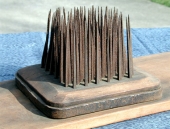
 7
7




Is it an herb, grain, vegetable, or ornamental bead? This easy-to-grow plant is all these things and more! With graceful and flowing miniature corn-type bladed leaves, sturdy stalks, delicate inconspicuous drooping flowers, and ornamental pea-like seeds, Job’s Tears adds a stunning green filler to cut flower displays. A grain-bearing plant useful for food, to make necklaces, rosary beads, and even traditionally in folk medicine for arthritis and to remove heat! Once the husk has been removed for cooking, the grains look more like oversized pearl barley. Great in brothy dishes and traditional Asian drinks, Job’s Tears provides a chewy, mildly sweet, and earthy flavor that has caught the eye of discerning cooks. It has lovingly been called by cookbook authors “the next cult gluten-free grain” and an “unusual, versatile, and beneficial little weirdo.”

Pecan Media: food forestry and forest garden ebooks
Now available: The Native Persimmon (centennial edition)
 2
2




 4
4




 1
1




 1
1




Pecan Media: food forestry and forest garden ebooks
Now available: The Native Persimmon (centennial edition)
 5
5




 1
1




Pecan Media: food forestry and forest garden ebooks
Now available: The Native Persimmon (centennial edition)
 1
1




 2
2




Pecan Media: food forestry and forest garden ebooks
Now available: The Native Persimmon (centennial edition)
 2
2




 4
4




Job's Tears (called Hato Mugi, in Japanese) is an uncommon grain eaten traditionally from Africa to Japan. It is believed to originate in India, but is most popular as food and medicine in China and Japan. Most Job's Tears grown in this country is of the non-domesticated type, with rock-hard shells that can only be cracked with pliers or a hammer. The grain inside is edible, but very hard to get at. The domesticated "ma-yuen" type (Coix lacryma-jobi var. ma-yuen) can be cracked open with a couple strong human fingers or a normal threshing machine.
Pecan Media: food forestry and forest garden ebooks
Now available: The Native Persimmon (centennial edition)
 5
5




 5
5




Permaculture...picking the lock back to Eden since 1978.
Pics of my Forest Garden
 3
3




Permaculture...picking the lock back to Eden since 1978.
Pics of my Forest Garden
 7
7




Greg Martin wrote:Here's a video I was watching this morning that got me interested.
Pecan Media: food forestry and forest garden ebooks
Now available: The Native Persimmon (centennial edition)
 3
3




 6
6




Ellendra Nauriel wrote: Tumble them dry in a bucket with something abrasive for a few hours. Or maybe have some kind of abrasive surface attached to the insides of the bucket itself? Not sure.

 5
5




 6
6




As a farmer, I am a steward of the land and it’s animals.
My job is to feed both people and nature, to build up the world around me.
Farmers are healers of the land and providers of the people.
I will do my best to keep a clean and healthy environment that would be pleasing to God
 4
4




Permaculture...picking the lock back to Eden since 1978.
Pics of my Forest Garden
 5
5




Greg Martin wrote:Jordy, is it surviving winters for you or is it going to seed in one year and self seeding?
As a farmer, I am a steward of the land and it’s animals.
My job is to feed both people and nature, to build up the world around me.
Farmers are healers of the land and providers of the people.
I will do my best to keep a clean and healthy environment that would be pleasing to God
 4
4




Jordy Buck wrote:I'll add to this old thread. After growing this for a few years in Michigan (it's now going somewhat feral on my property) I can say it's functional if you get good at growing it. The grain hull is super hard, like flint corn. I'd recommend fermenting it (12-24 hours in water), roasting it, or both. That seemed to make the hull weak enough to be easily enough chewed. Cooking further softened them.
 3
3








Zone 6, 45 inches precipitation, hard clay soil





|
There will be plenty of time to discuss your objections when and if you return. The cargo is this tiny ad:
The new permaculture playing cards kickstarter is now live!
https://www.kickstarter.com/projects/paulwheaton/garden-cards
|





